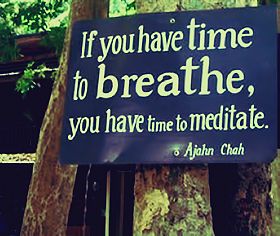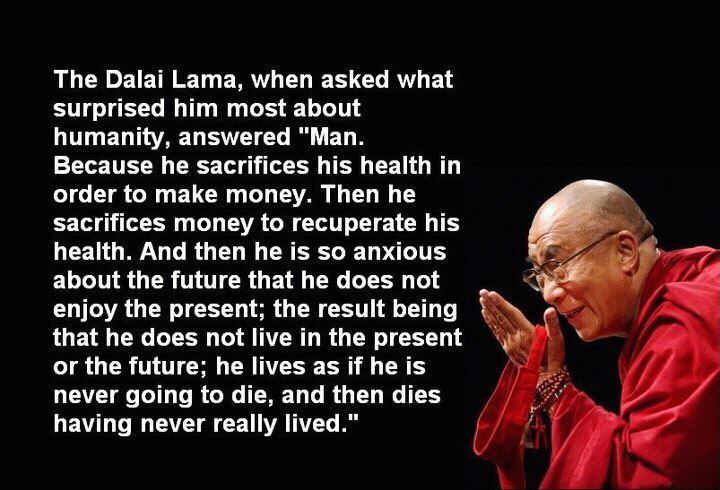The Practice of Meditation

(Beki Dodd)
Introduction~
Meditation is a way of letting go of your thoughts and worries and focusing your attention on a simple item such as breathing. As you grow in your practice, completely leaving your awareness comes with ease as you transcend your body and mind and enter a state of pure relaxation. There have been several studies showing the health benefits of meditation as well as the increased mental awareness of those who routinely practice meditation. Meditation can be done anywhere at any time. All it requires is you... (Beki Dodd)



Peer-Reviewed Journal Articles:
Fredrickson, B., Cohn, M., Coffey, K., Pek, J., & Finkel, S. (2008). Open hearts build lives: positive emotions, induced through loving-kindness meditation, build consequential personal resources. Journal of Personality and Social Psychology, 95(5), 1045-1062. (Beki Dodd)
Summary: In this article the authors test whether the practice of loving-kindness meditation can improve positive emotions which are suspected to cause a compounding effect that influences daily perceptions of experiences. In the study, the results indicate that incorporating mediation practice increased daily experiences of positive emotions and improved mindfulness, feelings of life purpose, social support, as well as decreased symptoms of illness. Participants in the meditation group also had greater life satisfaction and showed fewer symptoms of depression. (Beki Dodd)
Luders, E., Toga, A., Lepore, N., & Gaser, C. (2009). The underlying anatomical correlates of long-term meditation: Larger hippocampal and frontal volumes of gray matter. NeuroImage, 45(3): 672-678. (Beki Dodd)
Summary: In this study the authors test the effects of meditation on the brain using high-resolution MRI in a small sample of participants (44 subjects). The results showed increased gray matter volume in people who practiced meditation in the right orbito-frontal cortex, right thalamus, left inferior temporal gyrus, as well as increased total brain volume in the right hippocampus. The authors note that these areas are often associated with positive emotions, emotional stability, and mindfulness. (Beki Dodd)

Lutz, A., Brefczynski-Lewis, J., Johnstone, T., Davidson, R. (2008). Regulation of the Neural Circuitry of Emotion by Compassion Meditation: Effects of Meditative Expertise. PLoS ONE 3(3), e1897. doi:10.1371/journal.pone.0001897. (Beki Dodd)
Summary: In this study the authors investigate if reactions to emotional and/or neutral sounds are increased during meditative states while subjects practiced loving-kindness-compassion meditation. Further, the authors investigated the reactions of both novice and expert meditators and compared the results. Functional magnetic resonance imaging (fMRI) was used to detect changes in activation of certain areas of the brain. The authors found that during meditative practice there was greater activation of the limbic regions which varied based on positive, negative, or neutral sounds. Also, expert meditation practitioners showed higher activation in these areas compared with novice practitioners as well as higher responses to all sounds showing greater detection of emotional noises. The authors further discuss the implications of the findings and how meditation might be used to improve brain function as well as how the limbic system is shown to be associated with emotions. (Beki Dodd)
Books on Meditation:
Jyotirupananda, D. (2009). Meditation: Searching for the Real You. The Bothy, Deershot Lodge, Park Lane, Ropley, Hants, UK: John Hunt Publishing, Ltd. (Beki Dodd)

Book Description: This book will provide you with tools that can help you to meditate and will help you gain a stronger commitment to regular meditation practice. Learn about how to meditate, about yoga exercises and related practices. Learn how to be healthy through your own efforts and how to adopt a code of conduct that will see you through life's difficulties, and will help guide you to the deepest fulfillment.
(Retrieved from: http://www.amazon.com/Meditation-Searching-Real-Dada-Joyotirupananda/dp/1846942195)
Lama, D. (2001). Stages of Meditation. Ithaca, NY: Snow Lion Publications. (Beki Dodd)

Book Description: The Dalai Lama explains the principles of meditation in a practice-oriented format especially suited to Westerners. Based upon the middle section of the Bhavanakrama by Kamalasila, a translation of which is included, this is the most extensive commentary given by the Dalai Lama on this concise but important meditation handbook. It is a favorite text of the Dalai Lama and he often takes the opportunity to give teachings on it to audiences throughout the world. In his words, "This text can be like a key that opens the door to all other major Buddhist scriptures."
Topics included are: the nature of mind, how to develop compassion and loving-kindness, calm abiding, wisdom, and how to establish a union of calm abiding and special insight.
(Retrieved from: http://www.amazon.com/Stages-Meditation-Dalai-Lama/dp/1559391979/ref=sr_1_18?s=books&ie=UTF8&qid=1341897814&sr=1-18&keywords=meditation)
Nabhaniilananda, D. (2006). Close Your Eyes and Open your Mind: An Introduction to Spiritual Meditation. Waitsfield, VT: Inner World Publications. (Beki Dodd)

Book Description: A beginners guide to spiritual meditation, this covers commonly asked questions, mantra meditation, sense withdrawal and concentration, the law of karma, intuition, and the role of a spiritualist in the world. It offers a simple but profound description of the true meaning of meditation, taking the reader well beyond stress management and relaxation. Full of stories, anecdotes and gentle humour this book makes the philosophy behind meditation accessible to both beginners and experienced meditators.
Media:
Thirty minutes of relaxing imagery and sounds to help with meditation practices. (Beki Dodd)
One hour guided meditation video. (Beki Dodd)
10 minute video for quick relaxation and meditation. (Beki Dodd)
Websites:
- Maharishi Foundation USA. (2012). The Transcendental Meditation (TM) Program. Retrieved from http://www.tm.org/ (Beki Dodd)
Description: Founded by Maharishi Mahesh Yogi, "The transcendental Meditation technique is a simple, natural, effortless procedure practiced 20 minutes twice each day while sitting comfortably with the eyes closed. It’s not a religion, philosophy, or lifestyle. It’s the most widely practiced, most researched, and most effective method of self-development," (Maharishi Foundation USA). (Beki Dodd)

- Mayo Clinic Staff. (2011). Meditation: A Simple, Fast Way to Reduce Stress. Retrieved from http://www.mayoclinic.com/health/meditation/HQ01070 (Beki Dodd)
Description: The site discusses clinical information about the background, benefits, effects and types of meditation. Also covered are the different elements of meditation as well as tips to effectively practice and improve meditation (Beki Dodd)

- National Center for Complementary and Alternative Medicine. (2012). Meditation. Retrieved from http://nccam.nih.gov/health/meditation (Beki Dodd)
Description: The National Center for Complementary and Alternative Medicine (NCCAM) website offers information regarding meditation as well as other forms of complementary medicine. In the section regarding meditation, readers can find current research, practice guidelines, on-going medical research studies, multimedia, as well as information composed for both the general public and healthcare providers. The site also offers continuing education units and potential funding sources for future research. (Beki Dodd)

Meditation Quotes:
(Beki Dodd)
Themes:
- Breath- The topic of breath and breathing comes up many times in meditation. Focusing on the breath and feeling the air as it moves through the body can help to achieve a higher meditative state. By maintaining the attention on this simple action without inhibiting our body's natural ability to breathe autonomously, it is possible to achieve a more relaxed state where the mind is free and the body is at ease. (Beki Dodd)
(Beki Dodd)
- Being- In meditation, the goal is to simply be. Thoughts and actions are let go as the body sinks into a calm state of near nothingness. To understand our thoughts, we must let them go and in a sense go into a state beyond knowing and thinking. We free our mind from the prison of the body and let it function in a higher state beyond what we attempt. We achieve when we no longer try to achieve and simply be. (Beki Dodd)
(Beki Dodd)
- Inner Peace- When meditation is practiced effectively, the common result is a feeling of inner peace. It is a true joy and love for thyself and the environment in which we live. The body and mind no longer struggle amongst each other, but operate in a symphonic unison allowing us to experience absolute bliss. The wish is for all to achieve inner peace. (Beki Dodd)

(Beki Dodd)
This is a slideshow I created to show my personal perspective of meditation. (Beki Dodd)
Practice Summary Application: (Corina Noble)
The lessons I learned while doing this practice of meditation were quite surprising. I found that I could calm my mind chatter and get good, restful sleep if I used this practice before bed. I learned that it doesn’t take a lot of time to do a meditation and have it give you its benefits. I only did 10 minutes and saw its benefits right away the first week. I learned it could also focus my thoughts and help me concentrate. I felt happier and more rested the next day and able to deal with the stressors in my life better. I have a way to deal with my mind chatter and insomnia issues and will use it to deal with them happily from now on.
The personal uses for this practice have many applications but the first suggestion is for any parent out there trying to keep all the balls in the air. Taking the 10 minutes to sit and meditate will enable a parent to regroup their thoughts, calm some unnecessary worries and be able to take on the many tasks again with a clear head. Another personal use could be for the student. When one is suffering from anxiety over the studies or worrying about a test, this practice could bring some calmness and clarity. I would recommend doing the practice right before tests even to try to bring focus to your thoughts and help you concentrate on the coming challenge.
The professional uses for this practice have been shown to be a success in many avenues through our studies too. One such use would be for the general worker feeling overwhelmed or stressed at work. They could use it to bring back calm, collected thoughts to tackle the problems faced thus relaxing and reducing the stress also. An owner or manager could use this practice to promote a relaxed but focused group to brainstorm creatively for a new project. In the medical setting, a patient could use the practice to cope with a disease or symptoms more effectively. It can even be focused on the body itself by patients to promote healing from within to complement any treatment being administered by health care professionals. (Corina Noble)






